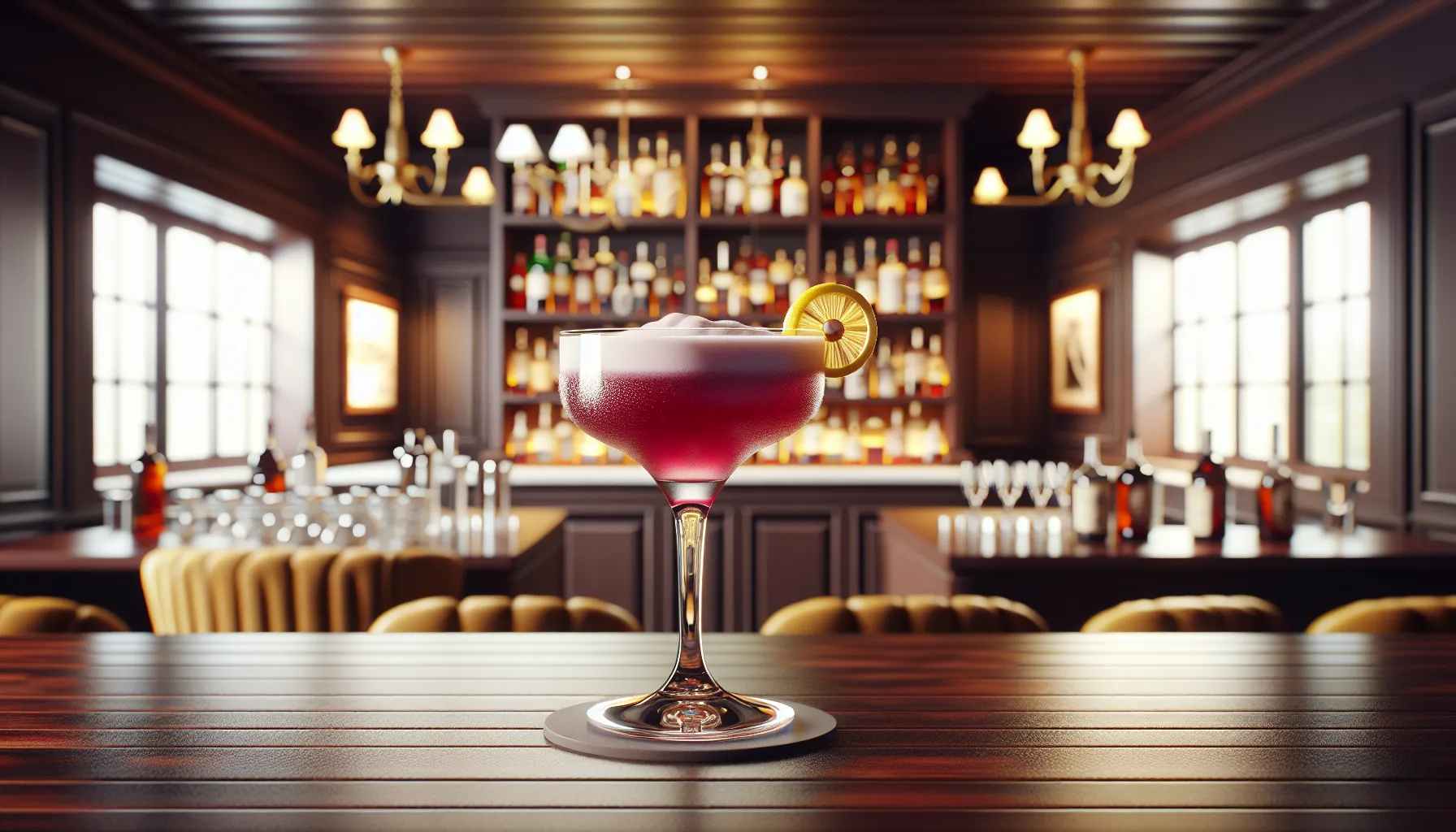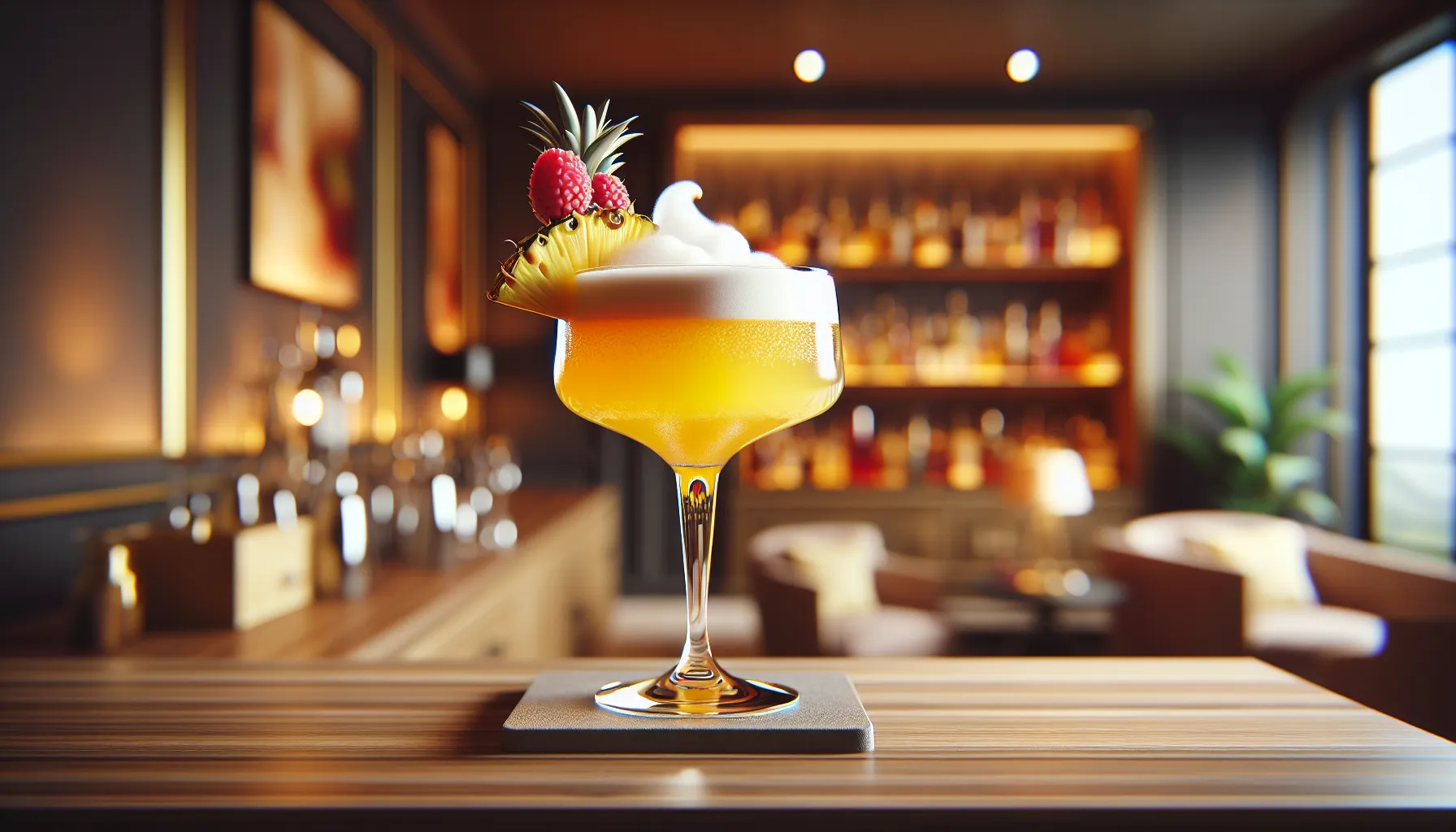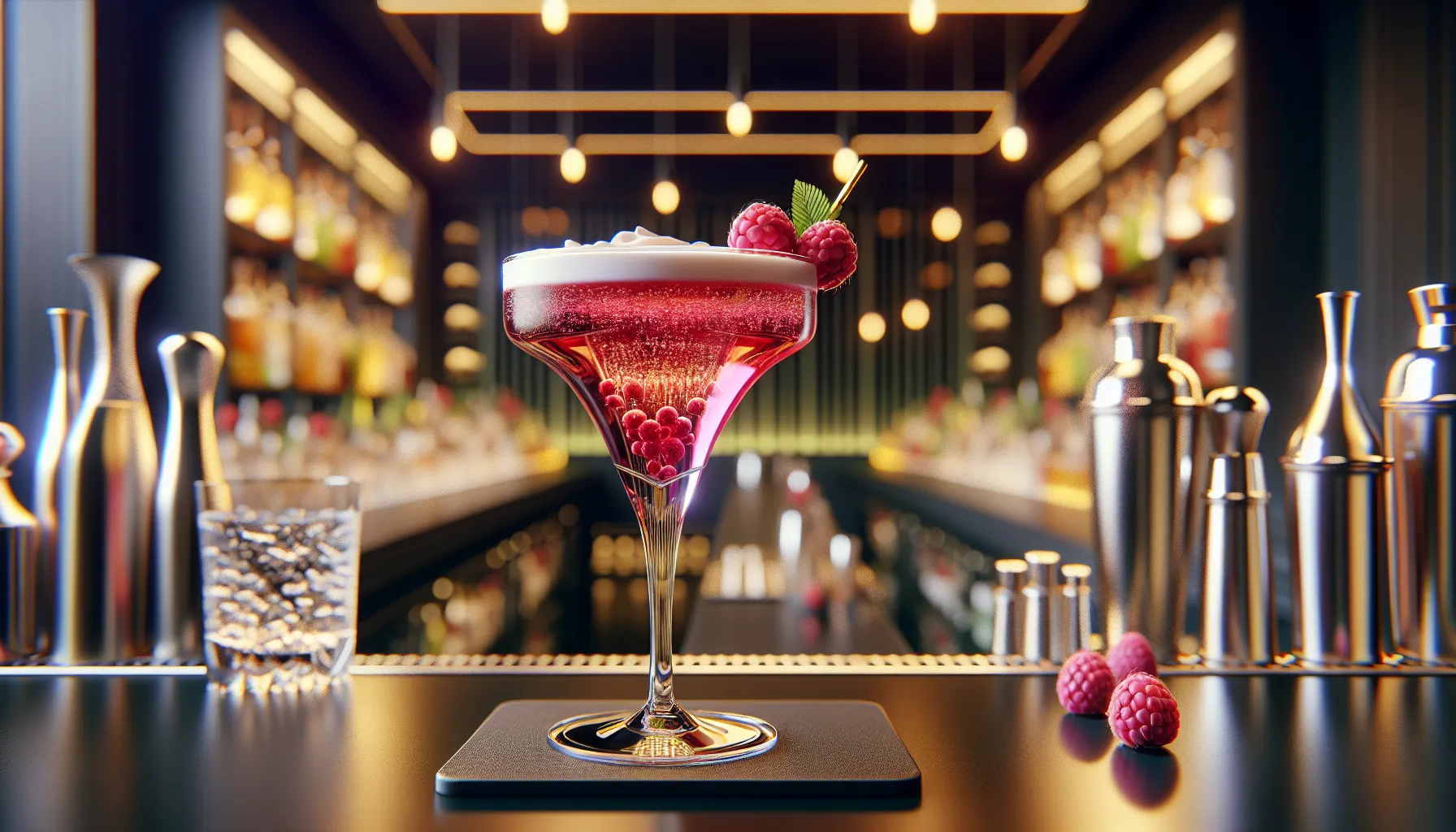Key Takeaways
- The French Martini is a three-ingredient vodka cocktail made with pineapple juice and Chambord, shaken hard for a frothy, silky finish and served in a chilled martini or coupe glass.
- Originating in late-1980s New York, it’s not a true martini—its fruity, modern profile swaps gin and vermouth for vodka, pineapple, and raspberry liqueur.
- Best base recipe: 2 oz vodka, 1.5–2 oz fresh pineapple juice, 0.5–0.66 oz Chambord; shake 12–15 seconds with large ice and double strain for a glossy foam cap.
- Keep garnishes simple—lemon twist or fresh raspberry—and balance sweetness/acidity with small tweaks (lemon or citric solution) to avoid cloying or flat flavors.
- Easy to customize and scale: try raspberry- or vanilla-forward variations, low-ABV and zero-proof builds, and pre-diluted party batches for effortless service.
I fell for the French Martini the first time I saw that golden foam kiss the rim. It looks glamorous and it tastes playful. With bright pineapple and a hint of berry it turns an ordinary night into a little celebration.
I reach for it when I want something simple yet elegant. It mixes in minutes and feels like a treat. In this guide I’ll share what makes it special plus tips for a smooth shake and a balanced sip. Whether you host friends or unwind after work you can bring a touch of Paris chic to your glass.
What Is A French Martini?
I define a French Martini as a three‑ingredient vodka cocktail with pineapple juice and Chambord. I shake it hard for froth and serve it up in a chilled martini glass for a glossy finish.
A Brief History And Origins
I trace the drink to New York in the late 1980s during the flavored “martini” wave, then see its fame spike across the 1990s as Chambord pushed berry‑driven recipes (Difford’s Guide, Liquor.com, Punch).
| Year | Place | Note |
|---|---|---|
| 1980s | New York | Emerges during the vodka and fruit “martini” trend (Difford’s Guide) |
| 1990s | US bars | Gains menu traction through Chambord marketing and cocktail lists (Punch, Liquor.com) |
| 1996 | Balthazar, New York | Appears on the opening list and helps codify the spec (Difford’s Guide) |
Sources: https://www.diffordsguide.com, https://www.liquor.com, https://punchdrink.com
Flavor Profile And Why It’s Not A True Martini
I describe the flavor as bright pineapple with a ripe raspberry core and a soft vanilla edge from Chambord, then a silky foam that softens the finish.
- Uses vodka, pineapple juice, and Chambord, not gin and dry vermouth, so it departs from the classic build (Difford’s Guide).
- Leans fruity and lush, not dry and juniper‑led, so it reads as a modern vodka sour in a martini glass (Punch).
- Draws its “French” tag from Chambord, not from technique or origin, so the name signals flavor more than category (Liquor.com).
- Pours with froth and medium body, not with the lean clarity of a stirred martini, so texture shifts the experience.
I keep garnishes minimal with a lemon twist or a fresh raspberry for aroma and color examples.
Ingredients And Tools

I stock a short list for a classic French Martini. These ingredients and tools keep the shake cold and the texture frothy.
Core Ingredients
Core ingredients define flavor and texture.
- Vodka: Clean, neutral vodka lets bright pineapple and raspberry shine.
- Pineapple juice: Fresh pressed juice creates fine foam and a vivid tang.
- Chambord: Black raspberry liqueur adds berry depth and a soft vanilla edge.
- Ice: Large, hard cubes chill fast and limit dilution.
| Component | Amount (oz) | Amount (ml) |
|---|---|---|
| Vodka | 2.0 | 60 |
| Pineapple juice | 2.0 | 60 |
| Chambord | 0.5 | 15 |
Recommended Brands And Substitutions
Recommended brands and smart swaps keep balance and color.
- Vodka: Absolut, Ketel One, Grey Goose deliver clean structure.
- Pineapple juice: Fresh pressed juice from ripe fruit foams best, Dole 100% Pineapple Juice works for consistency.
- Chambord: Chambord 16.5% ABV sets the benchmark, Giffard Framboise de Ronce gives a drier berry note.
- Raspberry liqueur blend: 2 parts raspberry liqueur to 1 part crème de cassis mimics Chambord richness at 0.5 oz total.
- Vanilla accent: 1 to 2 drops vanilla extract lift the finish if the vodka tastes ultra neutral.
Glassware And Equipment
Glassware and equipment lock in chill and presentation.
- Coupe or martini glass: Chilled stemware keeps the froth stable and the color vivid.
- Shaker: Cobbler or Boston shaker aerates the mix for a tight foam cap.
- Hawthorne strainer: Spring tension holds back big ice shards during the pour.
- Fine strainer: Mesh filter polishes texture and removes pulp for a sleek surface.
- Jigger: Marked 2 oz and 0.5 oz ends speed accurate builds.
- Peeler or channel knife: Lemon peel makes a clean twist for a bright aroma.
How To Make A French Martini

I mix a French Martini for bright pineapple foam and a clean raspberry core. I keep the recipe tight for balance and repeatability.
Step-By-Step Instructions
- Chill the glass in the freezer for 10 minutes for a frosty rim.
- Measure the vodka into a shaker for precision.
- Measure the pineapple juice next for maximum foam.
- Measure the Chambord last for color and aroma.
- Fill the shaker with solid ice for fast chilling.
- Shake hard for 12 to 15 seconds for fine aeration.
- Double strain into the chilled glass for a silky texture.
- Garnish and serve at once for peak foam.
Sources: Liquor.com recipe spec, 2 oz vodka, 1.5 oz pineapple, 0.5 oz Chambord (https://www.liquor.com/recipes/french-martini). Difford’s Guide spec variant, 2 oz vodka, 1.33 oz pineapple, 0.66 oz Chambord (https://www.diffordsguide.com/cocktails/recipe/833/french-martini). Serious Eats shaking guidance, 10 to 15 seconds with firm ice (https://www.seriouseats.com/how-to-shake-stir-cocktails-techniques).
Proportions, Ice, And Shake Technique
I use a classic French Martini ratio for consistent balance.
| Spec | Vodka (oz) | Pineapple (oz) | Chambord (oz) | Ice Type | Shake Time (s) |
|---|---|---|---|---|---|
| Liquor.com | 2.0 | 1.5 | 0.5 | Large cubes | 12–15 |
| Difford’s Guide | 2.0 | 1.33 | 0.66 | Large cubes | 12–15 |
| Sweeter tilt | 2.0 | 1.5 | 0.75 | Large cubes | 12–15 |
| Drier tilt | 2.0 | 1.75 | 0.33 | Large cubes | 12–15 |
- Choose large clear cubes for cold dilution, skip pebble ice for less foam.
- Aim for 20 percent dilution for balance, stop when the shaker turns frosty.
- Shake hard to whip pineapple proteins, keep the seal tight for pressure.
- Double strain to catch ice shards, keep the foam intact for lift.
Sources: Liquor.com, Difford’s Guide, Serious Eats as cited above.
Garnish Ideas
I finish a French Martini with simple garnishes that match the profile.
- Express a thin lemon twist over the foam for citrus oils.
- Skewer a fresh raspberry for color and aroma.
- Float a pineapple leaf for height and contrast.
- Mist a vodka atomizer once for brightness.
- Rim a quarter moon of the glass with fine sugar for texture.
Variations And Twists

I keep the french martini bright and plush, then I tweak the core to target raspberry depth or vanilla roundness. I stay within the pineapple, vodka, Chambord triangle, then I adjust sweetness or texture.
Raspberry Or Vanilla French Martini
I push raspberry or vanilla, then I balance acid with measured pineapple.
- Build, for 1 drink:
- Raspberry-forward: 1.5 oz vodka, 1.0 oz Chambord, 1.5 oz fresh pineapple juice, 0.25 oz lemon juice
- Vanilla-forward: 1.5 oz vanilla vodka, 0.5 oz Chambord, 2.0 oz fresh pineapple juice, 1 dash vanilla extract
- Add, precise tweaks:
- Add 0.25 oz crème de framboise, if the berry reads light
- Add 0.25 oz 1:1 simple syrup, if the pineapple tastes sharp
- Add 1 pinch saline solution 20 percent, if the finish needs lift
I keep foam high, then I shake hard with large ice for 12 seconds. I express a lemon twist, then I garnish with a raspberry.
Variant builds
| Style | Vodka | Chambord | Pineapple juice | Acid or enhancer | Notes |
|---|---|---|---|---|---|
| Raspberry-forward | 1.5 oz | 1.0 oz | 1.5 oz | 0.25 oz lemon | Deeper berry, tighter finish |
| Vanilla-forward | 1.5 oz vanilla | 0.5 oz | 2.0 oz | 1 dash vanilla extract | Softer edges, longer foam |
| Extra-berry | 1.5 oz | 0.75 oz | 1.75 oz | 0.25 oz crème de framboise | Higher sugar, brighter color |
Low-Alcohol And Zero-Proof Options
I lower alcohol, then I hold the french martini flavor.
- Build, low-alcohol 1 drink:
- Use 1.0 oz vodka 40 percent ABV, 0.5 oz dry vermouth, 0.75 oz Chambord, 2.0 oz pineapple juice
- Build, zero-proof 1 drink:
- Use 1.5 oz vodka-style non-alcoholic spirit, 0.75 oz raspberry cordial 1:1, 2.0 oz pineapple juice, 0.25 oz lemon juice
I make raspberry cordial, then I combine 1 part raspberry purée, 1 part sugar, 1 splash lemon, 1 pinch salt. I shake hard for foam, then I dry shake for 5 seconds before ice if the non-alcoholic spirit lacks body.
- Calibrate, fast rules:
- Reduce sweet by 0.25 oz total, if using carton pineapple
- Add 2 dashes orange bitters NA, if the mid-palate feels flat
Sources: Standard vodka runs 40 percent alcohol by volume under US labeling, 27 CFR 5.141. Non-alcoholic beverages sit under 0.5 percent ABV, 27 CFR 7.71.
Batch And Pitcher-Friendly Versions
I scale the french martini, then I pre-dilute for service.
Party batch, 8 servings
| Component | Amount |
|---|---|
| Vodka | 12 oz |
| Chambord | 6 oz |
| Fresh pineapple juice | 16 oz |
| Cold water pre-dilution | 6 oz |
| Lemon juice optional | 2 oz |
| Yield | 40 oz |
- Combine, chilled pitcher, vodka, Chambord, pineapple, water, lemon
- Stir, 30 seconds
- Refrigerate, 2 hours
- Pour, 5 oz per serving, into chilled coupes
- Garnish, lemon twist, raspberry
I add water, then I skip shaking during service. I increase pineapple to 18 oz, if guests prefer extra foam on a quick shake with ice. I strain pineapple through a fine mesh, if pulp collects on the surface.
Serving And Pairing Suggestions
I serve a French Martini when I want bright pineapple foam and a clean raspberry core. I pair it with food that amplifies fruit acidity and balances vodka strength.
When To Serve A French Martini
- Aperitif: I pour it before dinner to spark appetite with pineapple acids and light sweetness.
- Brunch: I swap mimosas for a French Martini when citrus feels harsh.
- Cocktail hour: I feature it at 5 pm for a first round that tastes elegant and easy.
- After dinner: I use it as a light finisher when guests skip rich digestifs.
- Celebrations: I batch it for parties and toast with coupes for a glam moment.
- Poolside: I shake it cold and keep it short when heat asks for refreshment.
| Serving spec | Value |
|---|---|
| Standard pour | 3 to 3.5 oz before dilution |
| Typical dilution | 20% to 30% after a hard shake (Liquid Intelligence, Dave Arnold) |
| Final ABV | ~14% to 18% depending on vodka strength and dilution (Difford’s Guide) |
| Serving temp | 32°F to 38°F after shaking with ice |
| Glassware size | 5 to 7 oz coupe or martini glass |
Food Pairings That Complement The Cocktail
- Salty snacks: I match pineapple lift with prosciutto, Marcona almonds, Castelvetrano olives.
- Creamy cheeses: I cut fat with fruit acid using triple cream Brie, Camembert, Humboldt Fog.
- Seafood bites: I echo coastal sweetness with shrimp cocktail, salmon nigiri, crab cakes.
- Spicy plates: I soften heat with ripe berry notes alongside chicken larb, spicy tuna, Sichuan wings.
- Fried textures: I cleanse palate with foam and acid next to tempura prawns, arancini, calamari.
- Fruit desserts: I mirror Chambord with raspberry tart, lemon posset, pineapple upside down cake.
- Chocolate treats: I contrast cocoa bitterness with a French Martini next to dark chocolate torte.
Sources: Liquid Intelligence by Dave Arnold, Difford’s Guide cocktail data.
Tips And Troubleshooting
I keep this section tight so you can dial in flavor and texture fast. I focus on balance, foam, chill, and clarity.
Balancing Sweetness And Acidity
Balancing sweetness and acidity defines a clean French Martini. I treat pineapple juice and Chambord as the sweet side and I use acid to lift the finish.
- Taste: Taste the base mix before ice to read sugar and acid.
- Measure: Measure with a scale or jigger for repeatable balance.
- Adjust: Adjust with small 0.15 oz moves to avoid swings.
- Add: Add lemon juice for classic acid or add citric solution for precision.
- Swap: Swap to drier vodka styles for less perceived sweetness.
- Check: Check foam and aroma after any acid tweak.
| Issue | Sensory cue | Precise tweak | New spec example |
|---|---|---|---|
| Too sweet | Cloying finish | Add 0.15–0.25 oz fresh lemon juice | 2 oz vodka, 1.5 oz pineapple, 0.5 oz Chambord, 0.25 oz lemon |
| Too flat | Low snap | Add 0.25 tsp 20% citric solution | 2 oz vodka, 1.75 oz pineapple, 0.5 oz Chambord, 0.25 tsp citric |
| Too tart | Sharp edge | Add 0.15 oz Chambord or 0.25 oz pineapple | 2 oz vodka, 1.75–2 oz pineapple, 0.5–0.65 oz Chambord |
| Too thin | Weak body | Reduce dilution by 10% shake time | 10–12 sec hard shake with big ice |
| Too heavy | Syrupy texture | Increase vodka by 0.25 oz | 2.25 oz vodka, 1.5 oz pineapple, 0.5 oz Chambord |
I cite Difford’s Guide for balance ranges in shaken sours and fruit cocktails, and I cite Serious Eats for acid adjustment methods in cocktail development.
Fixing Common Mistakes
Fixing common mistakes saves time and ingredients. I follow a quick checklist before I pour.
- Chill: Chill the glass for 10 minutes or pack with ice and water for 2 minutes.
- Shake: Shake hard for 10–12 seconds with large clear cubes.
- Strain: Double strain to catch pulp and ice shards.
- Press: Press the fine strainer lightly to layer foam on top.
- Juice: Use fresh pineapple juice within 24 hours for best foam.
- Ratio: Start 2:1.5:0.5 vodka to pineapple to Chambord for balance.
- Ice: Use dense ice to control dilution and keep texture tight.
- Garnish: Express a lemon twist over the foam or drop a raspberry for aroma.
- Batch: Pre-dilute 8–10% and keep chilled if batching for service.
- Replace: Replace Chambord with crème de framboise only if you lower the dose by 20%.
I cite Punch for batching dilution guidance in shaken cocktails, and I cite The Oxford Companion to Spirits and Cocktails for ingredient handling and freshness.
Conclusion
I hope this guide sparks your next happy hour. The French Martini has a way of turning a simple moment into a small celebration. Trust your taste and have fun with it. Sip slow and enjoy the glow.
If you try a twist you love tell me about it. I live for those little wins. Snap a photo and share it with friends. Then raise your glass with me. To bright flavors and easy joy. Cheers
Frequently Asked Questions
What is a French Martini?
A French Martini is a three-ingredient vodka cocktail made with pineapple juice and Chambord (raspberry liqueur). It’s shaken hard for a frothy top and served in a chilled martini or coupe glass. Bright, fruity, and elegant.
What does a French Martini taste like?
It’s vibrant and lush: bright pineapple up front, ripe raspberry in the middle, and a soft vanilla edge. It’s sweeter and fruitier than a classic gin martini, with a silky, foamy texture from shaken pineapple juice.
Is the French Martini actually French?
Not really. The “French” refers to Chambord, a French raspberry liqueur. The cocktail itself was created in New York in the late 1980s and became popular in the 1990s.
What are the core ingredients?
- Vodka
- Fresh pineapple juice
- Chambord Plus plenty of ice. Optional: a lemon twist or fresh raspberry for garnish.
What vodka and pineapple juice work best?
Choose a clean, balanced vodka like Absolut or Grey Goose. Use fresh-pressed pineapple juice for better flavor and a thick, lasting foam. Avoid canned juice with added sugar if possible.
How do I make a French Martini?
Chill your glass. Add vodka, pineapple juice, and Chambord to a shaker with large ice. Shake hard for 12–15 seconds until cold and frothy. Double strain into the chilled glass. Garnish with a lemon twist or raspberry.
Should I shake or stir it?
Always shake. Shaking aerates the pineapple juice, creating that signature foam and proper chill. Stirring won’t deliver the same texture or dilution.
How do I get a thicker foam?
Use fresh pineapple juice, large cold ice, and a hard, fast shake. Don’t over-dilute. Double strain to keep texture smooth while preserving the foam.
What glassware should I use?
A chilled coupe or martini glass is ideal. Freeze the glass for 10–15 minutes or fill with ice water while you mix, then dump before pouring.
How do I balance sweetness and acidity?
Taste and adjust: if it’s too sweet, add a splash more pineapple juice or a squeeze of lemon. If tart, add a small bump of Chambord or a touch more vodka for dryness.
What are easy flavor variations?
- Raspberry-forward: increase Chambord slightly.
- Vanilla-forward: use a vanilla vodka or add a tiny drop of vanilla extract.
- Drier: reduce Chambord and increase vodka.
- Brighter: bump pineapple juice.
Can I make a low-alcohol or zero-proof version?
Yes. Low-ABV: use less vodka and more pineapple; add a dash of Chambord. Zero-proof: swap vodka for cold water or nonalcoholic “vodka,” and use raspberry syrup instead of Chambord. Keep the hard shake.
How do I batch French Martinis for a party?
Combine vodka, pineapple juice, and Chambord in a 4:4:2 ratio by volume. Chill the mix well. Shake individual portions with ice before serving for foam, or add a small amount of cold water (about 15–20%) if serving stirred over ice.
What garnish works best?
A lemon twist adds aroma and brightness. A fresh raspberry brings color and a hint of tartness. A small pineapple leaf is a fun, tropical touch.
What foods pair well with a French Martini?
Try salty snacks, creamy cheeses, seafood bites, spicy dishes, fried appetizers, fruit tarts, or chocolate desserts. The cocktail’s fruity acidity cuts richness and soft sweetness plays well with heat.
How do I fix common mistakes?
- Too sweet: add pineapple or a squeeze of lemon; shake again.
- Too tart: add a dash of Chambord.
- Watery/flat: use larger ice and shake shorter but harder.
- No foam: use fresh juice and a vigorous shake.
- Warm glass: chill it before pouring.

